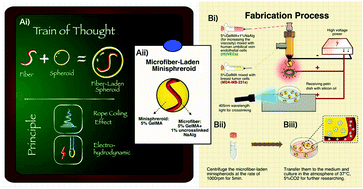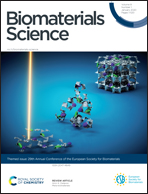3D biofabrication of microfiber-laden minispheroids: a facile 3D cell co-culturing system†
Abstract
Hierarchical tissues composed of spheroid and fiber structures such as tumors, embryos and glomeruli widely exist in organisms. Methods have been developed to build spheroid and fiber structures, independently, as tissue models in vitro. However, it is still a challenge to print them simultaneously and integrated for effectively mimicking the complicated situations in vivo. Here, we propose a novel 3D cell co-culturing system, “microfiber-laden minispheroid”, applying two fluidic phenomena, namely the “rope coiling effect” and “electrohydrodynamics”, with a co-axial bioprinting nozzle and high voltage system. Gelatin methacryloyl (GelMA) hydrogels were extruded from the outer nozzle and separated by electrical attraction to form spheroids (∼1800 μm). GelMA mixed with sodium alginate was extruded from the inner nozzle to form fibers (∼180 μm) inside spheroids, whose morphology could be controlled by the ratio of inner and outer nozzle extruding flow rates. We analyzed the fabrication process and the material system in detail, verifying the fabrication feasibility and suitable microenvironment. The encapsulated cells possessed high viabilities. Importantly, the actin of human umbilical vein endothelial cells tended to elongate towards the co-cultured tumor cells, in contrast to the HUVECs cultured alone. We believe that “microfiber-laden minispheroids” could be a potential system for 3D cell co-culturing research in the future.



 Please wait while we load your content...
Please wait while we load your content...